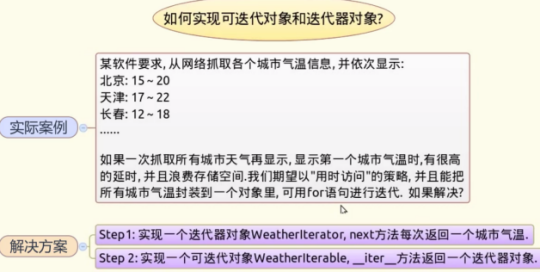3-2如何生成可迭代对象和迭代器对象

1、实现方法
使用第三方库requests,是python的一个HTTP客户端库,跟urllib,urllib2类似,那为什么要用requests而不用urllib2呢?官方文档中是这样说明的:
python的标准库urllib2提供了大部分需要的HTTP功能,但是API太逆天了,一个简单的功能就需要一大堆代码。
这个库可用在py2和py3中
参考资料:
(1)官方中文文档:http://cn.python-requests.org/zh_CN/latest/
(2)快速上手(官方中文文档) http://docs.python-requests.org/zh_CN/latest/user/quickstart.html
(3)PYTHON REQUESTS的安装与简单运用(张亚楠的博客):
http://www.zhidaow.com/post/python-requests-install-and-brief-introduction
(4)Python-第三方库requests详解:http://blog.csdn.net/shanzhizi/article/details/50903748
(5)python requests用法总结:http://www.cnblogs.com/lilinwei340/p/6417689.html
用浏览器打开天气预报:http://wthrcdn.etouch.cn/weather_mini?city=余杭
可以看到一个json格式的字符串,也可以看成是python字典,这个字典很长只有一行,下面是自己缩进之后的字符串
{ "data": { "yesterday": { "date":"27日星期三", "high":"高温 29℃", "fx":"北风", "low":"低温 20℃", "fl":"<![CDATA[3-4级]]>", "type":"阵雨" }, "city":"余杭", "forecast": [ { "date":"28日星期四", "high":"高温 20℃", "fengli":"<![CDATA[<3级]]>", "low":"低温 16℃", "fengxiang":"北风", "type":"阵雨" }, { "date":"29日星期五", "high":"高温 23℃", "fengli":"<![CDATA[<3级]]>", "low":"低温 20℃", "fengxiang":"东北风", "type":"阵雨" }, { "date":"30日星期六", "high":"高温 28℃", "fengli":"<![CDATA[<3级]]>", "low":"低温 21℃", "fengxiang":"东风", "type":"阵雨" }, { "date":"1日星期天", "high":"高温 31℃", "fengli":"<![CDATA[3-4级]]>", "low":"低温 23℃", "fengxiang":"南风", "type":"多云" }, { "date":"2日星期一", "high":"高温 29℃", "fengli":"<![CDATA[3-4级]]>", "low":"低温 21℃", "fengxiang":"北风", "type":"多云" } ], "ganmao":"相对于今天将会出现大幅度降温,易发生感冒,注意增加衣服,加强自我防护避免感冒。", "wendu":"17" }, "status":1000, "desc":"OK" }
一、简单示例,在py3中的代码:
#coding:utf8 #注py3要用 #coding=utf-8 import requests def getWeather(city): r = requests.get(u"http://wthrcdn.etouch.cn/weather_mini?city="+city) data = r.json()['data']['forecast'][0] return '%s: %s, %s'%(city,data['low'],data['high']) print(getWeather(u'杭州'))
输出:
杭州: 低温 16℃, 高温 21℃
二、实现可迭代对象和迭代器对象使用,实现复杂的示例
#collections模块下的Iterable可迭代对象和迭代器对象Iterator
#查看他们的抽象接口分别是next 和__iter__
>>> from collections import Iterable,Iterator >>> Iterator.__abstractmethods__ frozenset(['next']) >>> Iterable.__abstractmethods__ frozenset(['__iter__'])
在py3中的代码为

#coding:utf8 import requests from collections import Iterable,Iterator class WeatherIterator(Iterator): #定义一个可迭代天气的类,继承Iterable可迭代类 def __init__(self,cities): #构造函数,维护一个城市列表 self.cities = cities self.index = 0 #可迭代的序号 初始代为0 def getWeather(self,city): #将获得的天气信息函数封装类类中 r = requests.get(u"http://wthrcdn.etouch.cn/weather_mini?city="+city) data = r.json()['data']['forecast'][0] return '%s: %s, %s'%(city,data['low'],data['high']) def next(self): if self.index == len(self.cities):#当迭代到序号为列表长度,即为全迭代完,抛出异常 raise StopIteration city = self.cities[self.index] #获取当前列表序号的元素 self.index += 1 #迭代一次,序号加1 return self.getWeather(city) class WeatherIterable(Iterable):#定义一个天气的迭代器类,继承Iterator迭代器类 def __init__(self,cities): #构造函数,维护一个城市列表 self.cities = cities def __iter__(self): return WeatherIterator(self.cities) #print(getWeather(u'杭州'))
测试:
for x in WeatherIterable([u'北京',u'上海',u'广州',u'深圳',u'杭州']): print x
输出:
北京: 低温 11℃, 高温 22℃
上海: 低温 19℃, 高温 24℃
广州: 低温 26℃, 高温 36℃
深圳: 低温 28℃, 高温 34℃
杭州: 低温 16℃, 高温 21℃
过程:
(1)出现TypeError: object() takes no parameters 是因为构造函数__init__()名字不正确。
(2)类中的函数都要在第一个位置加self即始不使用,也必须加,与C++不同,C++中编译器自动加,python中必须手动加
(3)可迭代的接口是__iter__()在此函数中需返回迭代器对象。迭代器接口是next()
另一个天气预报网站:http://www.weather.com.cn
posted on 2018-04-13 11:04 石中玉smulngy 阅读(181) 评论(0) 收藏 举报




 浙公网安备 33010602011771号
浙公网安备 33010602011771号